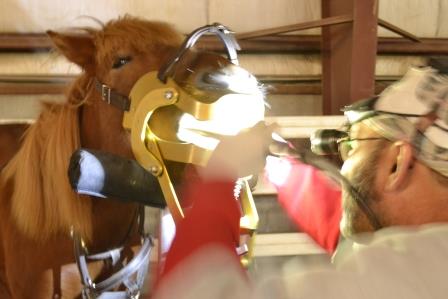
Home > Dispatches > Daily Dispatches 2014 >Daily Dispatch #254
September 24, 2014: Taking the Ponies to the Dentist: The March of the Molars
This morning we loaded all three ponies into the trailer and high tailed it over to the Rockin’ H where Dr. Wellington was to float their teeth. He was a few minutes late, and we were a few minutes early. This worked out well because I was able to take a bit of time and spiff up my oh so dirty critters. I have this theory – if your animals are clean and well behaved, your veterinarian and farrier will spend more time with you and answer any and all health-related questions. My theory was borne out yesterday. We spent the morning in the dark, dank, interior of the Rockin’ H arena. There Dr. |
|
| W and his assistant Donna again did what they’ve done so well in the past, which is tend to the molars and incisors of our one gelding, one mare, and one filly. First up was Tinni, who at 25 is now long in the tooth. Dr. W first took tartar off of his incisors, then with dremel tool in hand, filled down the sharp points on his molars. Tinni, drugged, stood with his feet splayed, and his eyes at half-mast. Donna, Dr. Wellington’s assistant, steadied him. When done, Dr. W filed his incisors, explaining that there needs to be a correspondence between the molar and the incisor length – when they’re in alignment, the horse can then move their molars cross-wise, and thus grind their forage. Done, Pete began walking Tinni and I went and got Hrimfara who was tied to the trailer. The little pinto filly was reluctant to enter the dark arena, so I let her graze for a bit – allowing her to lower her head did relax her some. She entered willingly when she heard Pete say her name and saw Tinni coming towards her. Like Tinni, Hrimfara was sedated, and her head on a stand. A speculum was put in place, and then Dr. Wellington cranked on it, opening her mouth. He pointed his headlight into her mouth cavity, and then pointed out that she had two small ulcers, one on each side of her mouth. This, I could see, was the result of her having points on her molars. The problem was taken care with the use of the dremel tool. Dr. Wellington and I had talked about his removing her wolf teeth, but only one had partially erupted while the other had not. So we’re going to wait until they materialize. Dr. Wellington explained to me that most horse tooth growth appears between 2-6 years. Hrimmi is now 2.5 years, so her teeth are going to need to be floated at least once a year for the next four years. Next up was Raudhetta, who in being left tied to the trailer, was by now beside herself (pun intended). Dr. Wellington (with all three horses) took their pulse with the stethoscope, and when asked said that doing this beforehand better enables him to determine the dosage. Raudi, being Raudi, required more of the drug than the other two. I was told that her teeth looked good, and that meant minimal filing. She did not, even after being drugged, relax like the other two did. Dr. Wellington finished up by lightly grinding her upper incisors. After Dr. Wellington was done with our horses, we walked them around the arena for a bit to help wear off the drug quicker. And then finally, after all had regained their balance, we put them back in the trailer. Surprise – next up was Kohlfaxi, Mariann Stoffel’s Icelandic horse. |
|
